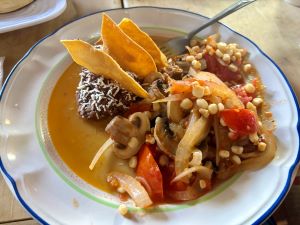My Experience Being Vegetarian in Xalapa, Veracruz, Mexico
By Nadely Requena, VRG Intern
Shortly before I began my second internship with The Vegetarian Resource Group, I was graciously able to travel to Xalapa, Veracruz, Mexico as I was chosen for a travel and research grant by the Teresa Lozano Long Institute of Latin American Studies at the University of Texas at Austin.
The purpose of my travel to the east coast of Mexico was to participate in the “Encuentro de Saberes y Sabores de la Huasteca” (Meeting of Knowledge and Flavors of the Huastec People).
As someone entering their final year of undergrad studying Journalism and Latin American Studies, it was quite amazing to be selected for this opportunity! Not only did I learn about the region, people, and culture, I also conducted my own research on the journalism practices relating to the covering of the Indigenous populations in Mexico, specifically the Huastec people. Being Mexican (Indigenous and Spanish)-American, I know my ancestors are always proud to see me returning to my roots.
More important than the knowledge, of course, were the variety of flavors (or sabores) acquired during this trip. For the past seven years, I have been vegetarian/vegan, first making the change when I was only 16 years old in high school.
When I’m in the comfort of my familiar home and restaurants, I remain vegan. Yet, this trip was different because for the first time, I wouldn’t be planning it. I wasn’t going to have to research all the restaurants in the area, go through endless menus to make sure there was at least one option for me, or even get the chance to refer to VRG’s restaurant guide and other sources to plan out my meals.
Yet, my anxious thoughts were soon calmed as I remembered how heavily my Mexican culture worships their plants, mainly corn (yes, we play favorites).
We were “plant-based” before those words even existed. It was only when Spanish and Portuguese colonizers came to the Americas in the 1700s when my ancestors were introduced to meat from domesticated animals and dairy products, like cheese.
Yet, even then and now, we continue to value our plants because it keeps us connected to the ground, the soil, our mother earth that we walk on. From corn, to beans, tomatoes, chilies, and guacamole, it’s in the food culture. So, trust there will be plenty of options for vegetarians and vegans when you visit our country! (Though you may need to ask questions, according to your belief system, as anywhere you would travel and eat out.)
During my travel to Xalapa, some dishes I tried are listed below, and hopefully they can make you feel right at home as they did to me! I will take this experience with me as I continue working with Latino communities in the US and in my career as a correspondent based in Latin America.
Breakfast:
- Pinto refried beans and sautéed cactus and white onions (Vegans should ask to leave out scrambled eggs which may come with it.)
- Sopes (or “picaditas,” “picadas” made in Veracruz style)
- These are corn masa cakes that look like mini tortillas with rounded and lifted edges like a mini pool
- Topped with red or green salsa, fresh cheese, sautéed onion, and cream (Vegans ask to leave out the cheese and cream.)
Lunch, Dinner, & Sides:
- Bocoles (or “gordita” as I know them, being from the northern part of Mexico; others know them as “arepas”)
- Topped with refried pinto beans, fresh cheese, and cactus (Vegans ask to leave off cheese.)
- Sopa de nopales (“cactus soup”)
- Contains cactus, red tomato (called “jitomate,” not “tomate” [green tomato]), onion, and garlic
- Optional: sweet corn, black beans, and green peas
- Sopa de tortilla (“corn tortillas soup,” also called sopa azteca or “Azteca soup”)
- Contains fried corn tortillas in a tomato soup with garlic, onion, and cilantro
- (You need to ask if this has chicken broth, cheese, or cream.)
- Sopa de habas (“fava bean soup”)
- Contains dried fava beans, onion, jalapeño, tomato, and cilantro
- French fries
- Important to note that in this part of Mexico, they call them “papas a la francesa” as opposed to “papas fritas” (as I call them)
- Vegans should ask what type of oil is used to fry these.
- Guacamole & Chips
- In addition, came with refried black beans, veggie fajitas, and grilled tofu
Desserts:
- Chocolate filled croissant with powdered sugar
- Atole de piña
- Atole: hot masa-based beverage
- Contains water, cinnamon, pineapple, and masa-harina (which is dried corn dough referred to as corn flour)
- Chancaca (or panela, pinocillo)
- It is unrefined whole cane sugar, known as Mexican brown sugar
- Can be added to dishes or eaten as a candy to experience an intense sweet flavor
THE salsa of Veracruz (most common, you will see EVERYWHERE):
- Salsa de chile seco (dried chili salsa)
- Very spicy (and that is coming from me, a person with a high spicy tolerance; I definitely recommend added it to your food for a little kick or for some, a trip to the bathroom)
If you are staying at home, some of these recipes and foods, may interest you.
https://www.vrg.org/journal/vj2006issue1/2006_issue1_bodega.php
https://www.vrg.org/journal/CookingAndRecipes.htm#cr-ethnic-mexican
https://www.vrg.org/journal/vj2021issue2/2021_issue2_latin_american_calcium.php

